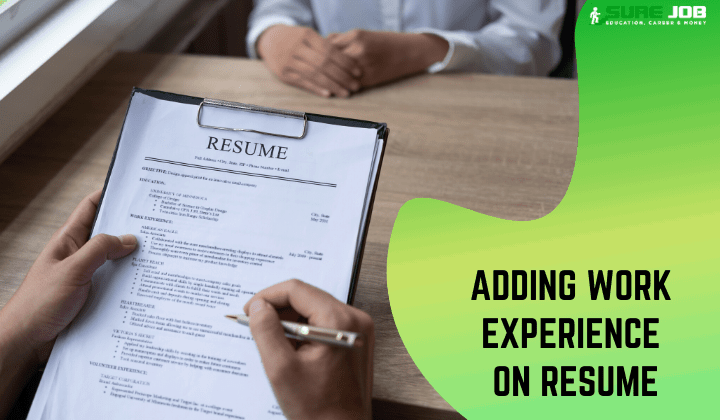Regardless whether you’re a fresher or experienced jobseeker, every employer wants to know about your work experience. Because work experience signifies your eligibility for the job.
Therefore, it’s extremely important to know how to add work experience on Resume and ensuring you’re providing the latest information.
How to add work experience on Resume? Read further. I’ll guide you step-by-step on how to create that killer, job-winning Resume.

Understanding Your Resume
The first step towards adding work experience on your resume is understanding the term Resume itself. If you’re unsure about what a Resume and how it differs from a Curriculum Vitae or Bio-Data, here’s an excellent resource to learn about it.
The term Resume traces its origin to the 18th and early 19th century French term that means ‘brief introduction’.
During the Industrial Revolution in Europe, workers from the countryside would flock to cities and industrial centers, looking for jobs.
Therefore, employers would ask jobseekers to write a brief description that includes their skills, experience, and education with a few other basic details.
It would help employers decide about employing a worker. The practice spread worldwide as France began colonizing various parts of the globe.
Who Asks for Resume?
The practice of asking jobseekers for a Resume continues till date. It’s an easy and simple way for jobseekers to highlight their academic qualifications and skills to employers.
A Resume enables employers to take quick decisions about calling a candidate for an interview. On a Resume, the focus is on two things: your educational qualifications and skills.
Generally, employers call for a Resume when an employer wants to know about your educational background for clerical, sales and marketing and other common jobs that don’t require specialized skills.
Jobseekers That Should Use Resume
Unless an employer asks for a different document, a Resume is useful for undergraduates, fresher applicants, graduates with minimal experience or first-time job changers.
That’s because an employer wants someone with a specific educational degree.
If you’re among such jobseekers, create an excellent resume that highlights your educational qualifications and experience in a superb manner.
The primary intent of your Resume is to impress the person that reads it and helps get you that call to interview.
Tips to Write a Resume
A resume should not exceed two printed or handwritten A-4 size pages. Hence, create a Resume using a Microsoft Word document. You can convert it later as PDF.
The second tip: A Resume is written in third person. Means, you’ll write about yourself as though you’re someone introducing another person.
And thirdly, an excellent Resume doesn’t contain very specific details such as your scores during any school, college or university final exams for getting your academic degree.
I’ll begin this article by speaking about how to metion work experience on your Resume.
How to Add Work Experience on Resume?
You’ve to add work experience on Resume after the educational qualifications. These have to be written in the chronological order. Meaning, you’ll start by writing about your first job or internship.
Here’s an example how you’ll describe work experience on a Resume.
Example of Work Experience on Resume
Mr. Pritam Nagrale began their career as intern/ designation at SureJob.com Ltd on 27/03/2009. Over a period of 10 months, they successfully executed 10 projects that involved Digital Marketing. Duties of Mr. Pritam Nagrale included:
- Search Engine Optimization: where Digital Marketing Skills from the MBA degree were useful.
- Social Media Skills: Allowed Mr. Pritam Nagrale an opportunity to practice social media marketing techniques learned while studying for the MBA.
- Team Leadership: Enabled Mr. Pritam Nagrale to utilize their leadership and manpower management abilities to meet deadlines set by SureJob.com Ltd.
When you follow this format, the employer finds it easy to read and understand your strengths and areas where you may require some development of skills or higher experience.
Adding More Work Experience on Resume
If you were working at any other organization after internship or your first job, write that too in the manner I’ve shown above.
Remember, each job and work experience description should not include more than five to six sentences of 20 to 25 words each.
Use points or numbers to make the Resume easy to read for the employer.
Remember, you’ve to start with your first internship or job and trace your employment history to the current or last employer.
Important Tips to Add Work Experience on Resume
Follow these three tips to add work experience on your Resume. A clear, simple and easy-to-read format usually attracts employers to invite you for an interview, if your experience and qualifications meet their needs.
- If you’re already working, do not disclose the name of your employer. An interviewer will ask that question anyways during an interview.
- Never mention your salary, names of seniors or persons whom you would report while working at any employer.
- Mention your successful projects without giving specific details.
Before proceeding further, here’s a question for you: Did you notice any specific pattern in the work experience example above?
Maybe not. Therefore, I’ll explain a little about that.
Blending Work Experience with Education
If you read the example above, it would be very clear that I have highlighted three main traits of the jobseeker.
The first point speaks about how the educational qualifications was useful in executing a specific task successfully.
The second point highlights a skill where the jobseeker requires additional experience.
And the third point speaks about the applicant’s personal skills.
That’s exactly how you can create an amazing job-winning Resume.
Adding Educational Qualifications on Resume
The above example of how to describe work experience on a Resume clearly shows how to write educational qualifications too.
Educational qualifications are also written as third party form on a Resume.
An example is: “Pritam Nagrale began studies when his parents enrolled him at the ABCD School in Mumbai in MMYY. He continued studies at this school till MMYY and successfully completed the Secondary School Certificate exam.”
“Upon completion of Higher Secondary Certificate from PQRS Junior College in Mumbai in MMYY, Mr. Pritam Nagrale opted for a Bachelor of Technology course at WXYZ Engineering College, Mumbai.
“With an aim of becoming a Digital Marketing professional, Pritam Nagrale studied MBA (Digital Marketing) at DXMM Management Institute, Mumbai and successfully completed the degree in MMYY.”
By this example, I’ve shown you how to blend in studies with your career objectives and link your educational qualifications with work experience.
More Tips on Adding Work Experience on Resume
Should you have got any promotions during tenure with any employer, there’s an excellent way to blend that in your work experience too.
Here’s an example.
- Search Engine Optimization: where Digital Marketing Skills from the MBA degree were useful. They worked on the process as Junior Digital Marketing Executive from DD-MM-YY to DD-MM-YY.
- Social Media Skills: Allowed Mr. Pritam Nagrale an opportunity to practice social media marketing techniques learned while studying for the MBA. As a result, they were promoted as Senior Digital Marketing Executive on DD-MM-YY.
- Team Leadership: Enabled Mr. Pritam Nagrale to utilize their leadership and manpower management abilities to meet deadlines set by SureJob.com Ltd. And was promoted as Digital Marketing Manager on DD-MM-YY till leaving the company on DD-MM-YY.
This format allows you to highlight your progress at a particular job with brief yet impressive details. And such details would definitely attract an employer.
Using Career Objective on Resume
Nowadays, Human Resources managers and experts have different opinions about Career Objective that most jobseekers write at the beginning of their Resume.
While some HR managers and experts believe the practice is old and useless because it doesn’t clearly show what a jobseeker wants. That’s because jobseekers themselves are unaware about how to write an excellent Career Objective.
Others believe that a Career Objective clearly indicates the mindset of a jobseeker. If the Career Objective language doesn’t match the rest of the Resume, it is a clear signal that the jobseeker is copying it from somewhere. This is a clear and sure sign of dishonesty.
Always Self-Attest Your Resume
Self-attesting your Resume indicates excellent professional etiquette. It is a clear indicator that you’re not lying. And that you’re responsible for the statements you are making on your Resume.
Add this simple line: “Details provided on this Resume are true to the best of my knowledge.” And sign on it with your name printed below.
Obviously, signing on an online Resume isn’t possible. In such cases, you can simply print your name. That too impresses employers.
Closing Thoughts
Hopefully, the above tips about how to add work experience on resume would help you bag that prized job to create an amazing career. Before concluding, here’s a word of warning.
Never cover up patches in your work experience due to unemployment for any reason. Most jobseekers try and cover up these patches by providing false dates of leaving or joining a company.
Remember, some companies utilize Employee Background Screening, Pre-Employment Screening and other processes to verify details on your Resume. If these checks find you’re providing incorrect information, you can lose the job opportunity and ruin your career.





